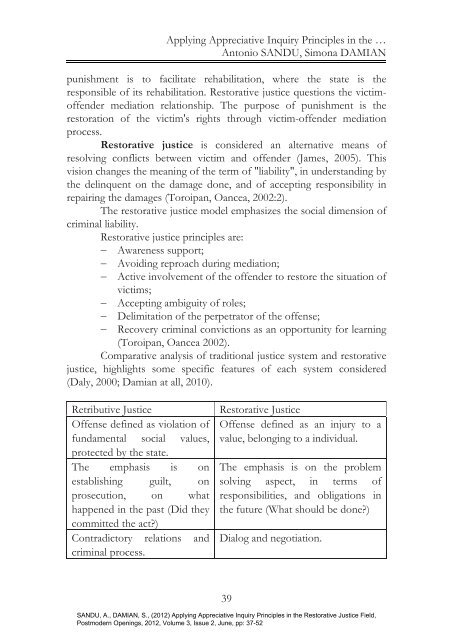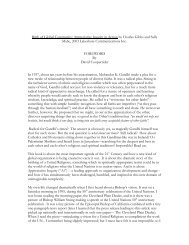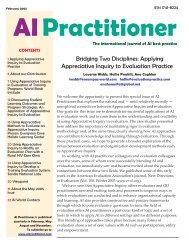Applying Appreciative Inquiry Principles in the Restorative Justice ...
Applying Appreciative Inquiry Principles in the Restorative Justice ...
Applying Appreciative Inquiry Principles in the Restorative Justice ...
Create successful ePaper yourself
Turn your PDF publications into a flip-book with our unique Google optimized e-Paper software.
<strong>Apply<strong>in</strong>g</strong> <strong>Appreciative</strong> <strong>Inquiry</strong> <strong>Pr<strong>in</strong>ciples</strong> <strong>in</strong> <strong>the</strong> …<br />
Antonio SANDU, Simona DAMIAN<br />
punishment is to facilitate rehabilitation, where <strong>the</strong> state is <strong>the</strong><br />
responsible of its rehabilitation. <strong>Restorative</strong> justice questions <strong>the</strong> victimoffender<br />
mediation relationship. The purpose of punishment is <strong>the</strong><br />
restoration of <strong>the</strong> victim's rights through victim-offender mediation<br />
process.<br />
<strong>Restorative</strong> justice is considered an alternative means of<br />
resolv<strong>in</strong>g conflicts between victim and offender (James, 2005). This<br />
vision changes <strong>the</strong> mean<strong>in</strong>g of <strong>the</strong> term of "liability", <strong>in</strong> understand<strong>in</strong>g by<br />
<strong>the</strong> del<strong>in</strong>quent on <strong>the</strong> damage done, and of accept<strong>in</strong>g responsibility <strong>in</strong><br />
repair<strong>in</strong>g <strong>the</strong> damages (Toroipan, Oancea, 2002:2).<br />
The restorative justice model emphasizes <strong>the</strong> social dimension of<br />
crim<strong>in</strong>al liability.<br />
<strong>Restorative</strong> justice pr<strong>in</strong>ciples are:<br />
Awareness support;<br />
Avoid<strong>in</strong>g reproach dur<strong>in</strong>g mediation;<br />
Active <strong>in</strong>volvement of <strong>the</strong> offender to restore <strong>the</strong> situation of<br />
victims;<br />
Accept<strong>in</strong>g ambiguity of roles;<br />
Delimitation of <strong>the</strong> perpetrator of <strong>the</strong> offense;<br />
Recovery crim<strong>in</strong>al convictions as an opportunity for learn<strong>in</strong>g<br />
(Toroipan, Oancea 2002).<br />
Comparative analysis of traditional justice system and restorative<br />
justice, highlights some specific features of each system considered<br />
(Daly, 2000; Damian at all, 2010).<br />
Retributive <strong>Justice</strong> <strong>Restorative</strong> <strong>Justice</strong><br />
Offense def<strong>in</strong>ed as violation of<br />
fundamental social values,<br />
protected by <strong>the</strong> state.<br />
The emphasis is on<br />
establish<strong>in</strong>g guilt, on<br />
prosecution, on what<br />
happened <strong>in</strong> <strong>the</strong> past (Did <strong>the</strong>y<br />
committed <strong>the</strong> act?)<br />
Contradictory relations and<br />
crim<strong>in</strong>al process.<br />
Offense def<strong>in</strong>ed as an <strong>in</strong>jury to a<br />
value, belong<strong>in</strong>g to a <strong>in</strong>dividual.<br />
The emphasis is on <strong>the</strong> problem<br />
solv<strong>in</strong>g aspect, <strong>in</strong> terms of<br />
responsibilities, and obligations <strong>in</strong><br />
<strong>the</strong> future (What should be done?)<br />
Dialog and negotiation.<br />
39<br />
SANDU, A., DAMIAN, S., (2012) <strong>Apply<strong>in</strong>g</strong> <strong>Appreciative</strong> <strong>Inquiry</strong> <strong>Pr<strong>in</strong>ciples</strong> <strong>in</strong> <strong>the</strong> <strong>Restorative</strong> <strong>Justice</strong> Field,<br />
Postmodern Open<strong>in</strong>gs, 2012, Volume 3, Issue 2, June, pp: 37-52






